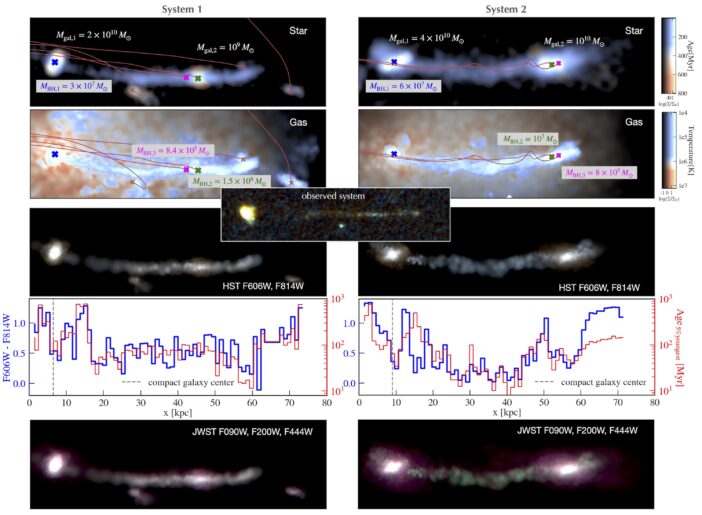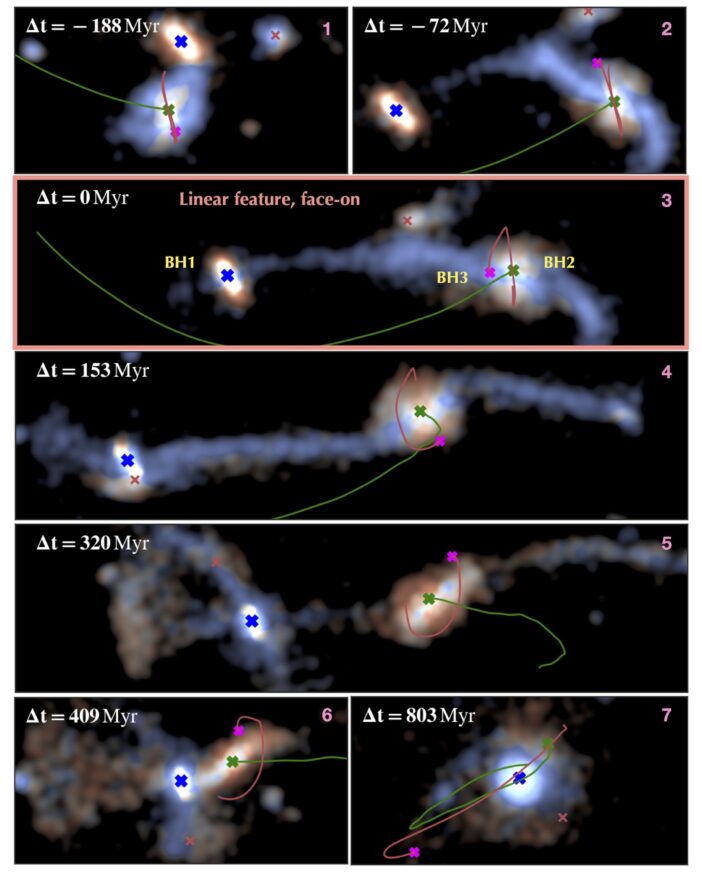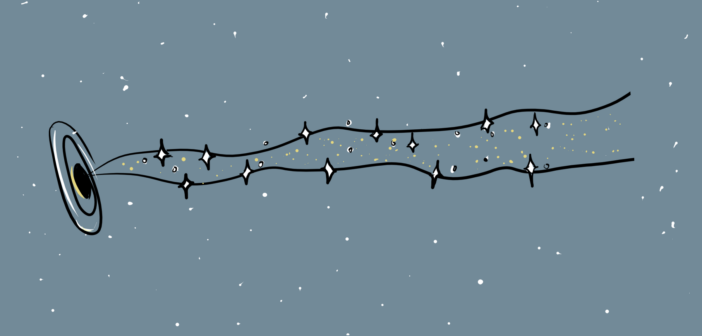Editor’s Note: Astrobites is a graduate-student-run organization that digests astrophysical literature for undergraduate students. As part of the partnership between the AAS and astrobites, we occasionally repost astrobites content here at AAS Nova. We hope you enjoy this post from astrobites; the original can be viewed at astrobites.org.
Title: Flyby Galaxy Encounters with Multiple Black Holes Produce Star-Forming Linear Wakes
Authors: Nianyi Chen et al.
First Author’s Institution: Carnegie Mellon University
Status: Published in ApJL
Earlier this year, a team of astronomers discovered a strange narrow twinkling trail of stars using the Hubble Space Telescope. This “linear feature” originates from the galaxy RCP 28 (Figure 1), stretching 200,000 light-years in length, and its origin is shrouded in mystery. Initially, this trail was thought to be caused by a “rogue” supermassive black hole that was ejected from its host galaxy. The rogue black hole would produce shock waves and light up the gas, leaving a long starry trail in its wake. The authors of today’s article, however, suggest an alternative scenario for the formation of this star-forming linear wake, backed by cosmological simulation studies.

Figure 1: Color image of the linear stellar wake generated using the filters F606W and F814W on the Hubble Advanced Camera for Surveys. [Adapted from van Dokkum et al. 2023]
However, it is still not clear if a supermassive black hole (with a mass around 10 million solar masses) can produce such a high level of star formation in its wake. This requires theoretical studies, and the first step would be to investigate linear wake features in cosmological simulations and trace their origins. This is precisely the approach that the authors undertake in today’s article.
Looking for Linear Wakes in Cosmological Simulations
The authors use ASTRID, a cosmological simulation with a large galaxy population, to explore potential connections between linear stellar wakes and runaway black holes. The updated black hole dynamics of ASTRID yield a large number of wandering black holes, some of which may arise due to interactions involving multiple massive black holes.
The authors initiate searches to find galaxies that match the properties of the one observed in the linear wake feature. The feature was observed at a cosmological redshift of z = 0.964, and the galaxies in the search are at a redshift of z = 1.3 (the current lowest-redshift simulation in ASTRID) and z = 2. Additionally, the authors seek out three-black-hole systems in these galaxy searches, as a three-body interaction is necessary for the production of a runaway black hole. They find around 200 potential runaway black holes in the target galaxies at a redshift of z = 2.
To search for linear wakes, the authors look for linear star-forming features around the target galaxies. They visually inspect the simulation output to find the features with the largest signal-to-noise ratio, finding around 30 linear feature candidates at each of the redshifts.
Now the big question is, do they find any star-forming wakes that match up with the passage of a runaway black hole? The authors surprisingly find no discernible association between runaway black holes and linear stellar features! So, if not runaway black holes, then what mechanism is responsible for generating these linear wakes?
Could a Fly-By Galaxy Encounter Be the Answer?
The authors find that most of the star-forming wakes originate from a fly-by encounter of a massive galaxy with a newly merged young galaxy hosting a black hole binary. To illustrate this, they present two representative cases of such systems observed in the simulation (see Figure 2). In the first two rows, we can see the galaxy that does a fly-by encounter with a younger galaxy containing two black holes (all black holes are marked by crosses). They also produce mock images of the systems as would be seen by the Hubble Space Telescope (third row) and JWST (fifth row). The ages of the stars along the wake are plotted in the fourth row, showing that half of the stars are relatively old (around 1 billion years) and the other half are younger (with age less than 100 million years). The Hubble filters effectively capture the younger stars within the linear wake, while JWST can detect older stars through longer-wavelength bands.

Figure 2: Row 1 and 2: The stars and gas associated with the linear stellar wake at redshifts of z~2 (left) and z~1 (right) systems. The linear feature observed is in the middle with the feature extending up to 160,000 light-years from the galaxy on the left of the image. Row 3: Mock image of the systems in Hubble F606W and F814W filters. Row 4: The color and age of the stellar population along the stellar wake. Row 5: Mock images of the systems in the longer-wavelength bands of JWST, revealing an older stellar population. [Chen et al. 2023]

Figure 3: Time evolution of the two galaxies (seen face on) and the associated black holes undergoing a fly-by encounter leading to the formation of the stellar wake. The central black hole in galaxy 1 is marked by the blue cross, and the two black holes in the tidally disrupted galaxy are in green and magenta. The green line indicates the path of black hole 2 relative to black hole 1, and the red line is for the orbit of black hole 3 relative to black hole 2. [Chen et al. 2023]
Future observations with JWST could shed further light on the origins of the star-forming wake. Using JWST’s long-wavelength bands, we can examine older stellar populations along the linear feature. Should such older stellar populations be identified along the feature, they would provide support for the galaxy fly-by encounter formation channel. Conversely, the lack of older stars would lend credence to the runaway black hole formation channel for the linear stellar wake.
Original astrobite edited by Lili Alderson.
About the author, Pranav Satheesh:
I am a first-year graduate student in physics at the University of Florida. My research focuses on studying massive binary and triple black holes, their interaction, and the outcomes of their mergers. In my free time, I love drawing, watching movies, cooking, and playing board games with my friends.

